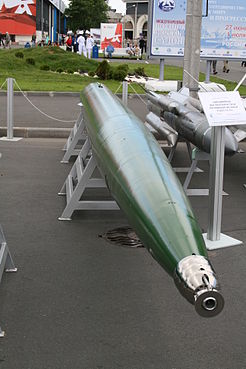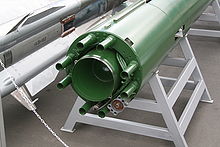Shkwal
| Shkwal | |
|---|---|
| General Information | |
| Designation: | VA-111 Schkwal |
| Country of origin: |
|
| Manufacturer: | GNPO region |
| Working time: | 1977 until today |
| Technical specifications | |
| Length: | 8.20 m |
| Diameter: | 533 mm |
| Combat weight: | 2,700 kg |
| Drive: | Solid - rocket engine |
| Speed: | 200 knots (370 km / h) |
| Range: | 11-15 km |
| Furnishing | |
| Warhead: | Nuclear warhead 2–5 kt |
| Target location: | no |
| Steering: | Inertial navigation platform |
| Weapon platforms: |
Primarily submarines , surface units possible |
| Lists on the subject | |
Shkwal ( Russian Шквал for storm gust , English transcription Shkval ) is the name of a torpedo developed in the Soviet Union with a reactive propulsion system that uses supercavitation to reduce flow resistance . The official designation of the Russian navy is VA-111 Shkwal .
development
Because of the secrecy in this sector, very little precise information about the technology and the area of application of the shkwal was made public. Research on supercavitation torpedoes at the NII-24 Applied Hydromechanics Research Institute began in the 1960s, where a prototype called the M-5 was developed. This had a rocket engine , which used hydrogen peroxide and kerosene as fuel . Based on the M-5 design, the VA-111 Shkwal was later developed in the GNPO Region design office . The first test samples were delivered to the Soviet Navy in 1977 . The production version was introduced in 1992.
description
The shkwal reaches a speed of over 370 km / h. It has a length of 8.2 meters and a weight of approx. 2700 kg. Before the main engine ignites, the shkwal is accelerated to the speed sufficient to generate the supercavitation by eight small starting engines distributed in a ring around the main engine. Gas discharge openings in the bow area also support the formation of super cavitation. On the rear part of the hull, runners / fins are unfolded after take-off, which reach into the water beyond the cavern. They stabilize the torpedo like a tail unit . After the start, the shkwal remains connected to the launch site via an uncoiling wire. Early versions were unguided, the newer models Schkwal-15 and Schkwal-15B have an actuator that can tilt the front of the cavitator in one plane. With the cavitator, which can only be moved around one axis, steering is possible in all directions, because the guide runners set the torpedo in rotation. A similar control principle is also used in some Russian anti-aircraft and anti-tank missiles; the helical course of the trajectory is characteristic .
One possible area of application for the Schkwal torpedo is to defend against enemy submarines . Since Soviet-made submarines were considered relatively noisy until around 1980, they were, for example, at a disadvantage compared to the comparatively quiet western hunting submarines. The launch of supercavitation torpedoes creates a time advantage due to their speed and the enforcement of defensive measures on the opposing submarine. Another conceivable variant of the Shkwal is the destruction of aircraft carrier combat groups using a nuclear warhead .
variants
| designation | description | Warhead | Range |
|---|---|---|---|
| M-5 | Initial unguided version, speed 194 knots | Nuclear warhead with 150 kt | 6.5-7 km |
| VA-111 Schkwal | First unguided production version, speed 200 knots | Nuclear warhead with 2–5 kt | 11 km |
| VA-111E Schkwal-E | Export version of the VA-111 from 1995 | conventional warhead, 350 kg | 7 km |
| Shkwal-15 | First version with wire steering | Nuclear warhead | |
| Shkwal-15B | Improved Schkwal-15 | conventional warhead, 100 kg | 11 km |
| Shkwal-2 | Improved version from 2005 with modified steering system | conventional warhead, 210 kg | 15 km |
| VA-111 Flurry-M | Trial version from 2010 with greater depth and range as well as higher speed |
distribution
The Shkwal weapon system was offered for sale to other states after the end of the Eastern Bloc by the successor states of the Soviet Union ( CIS ). Exports presumably went to Iran and China .


